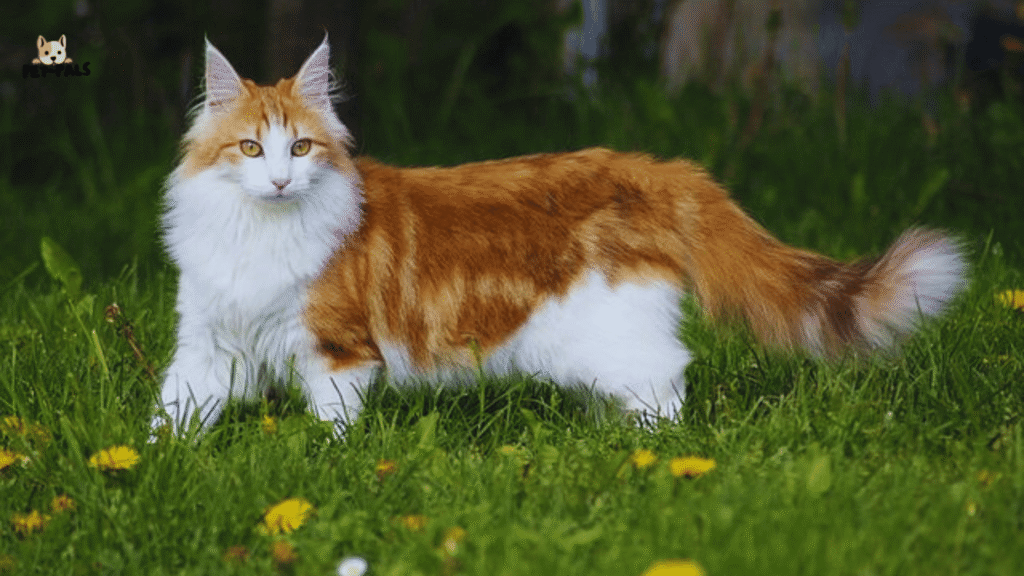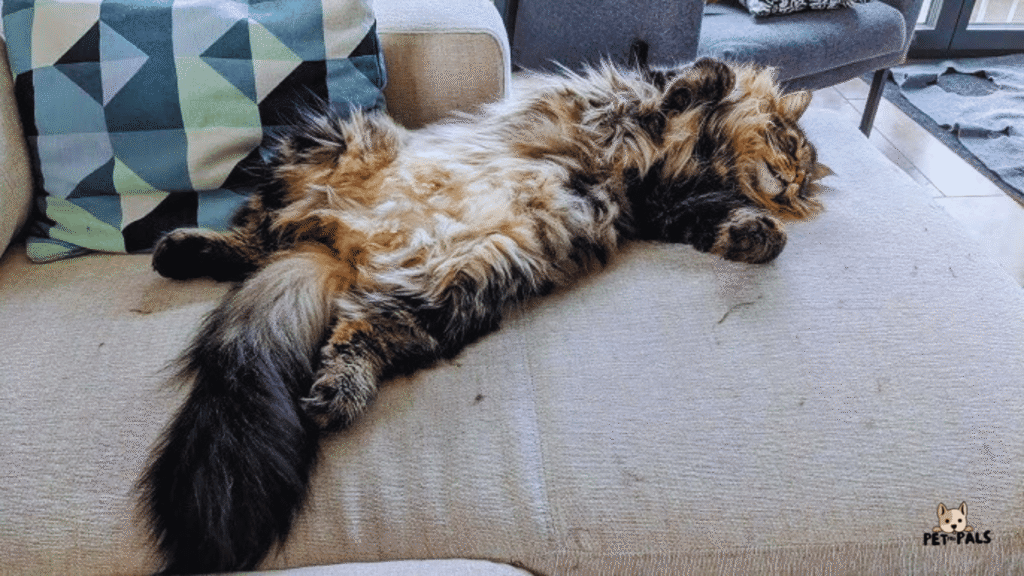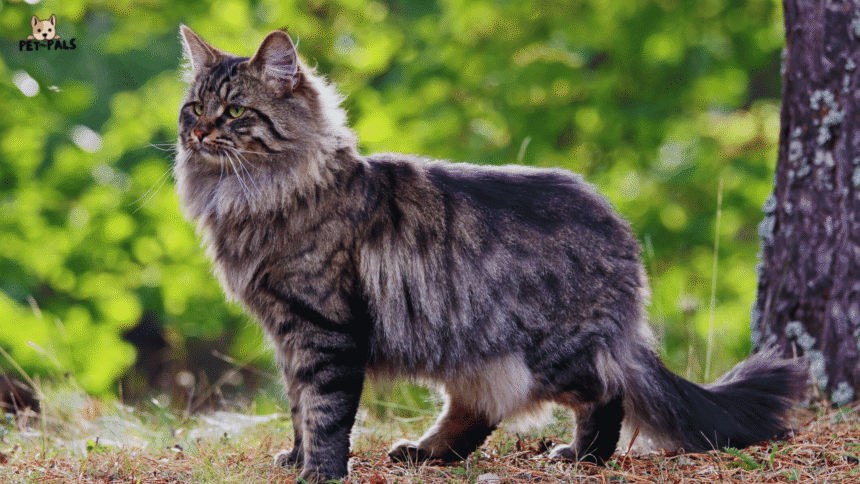If you’ve ever wanted a cat that looks like it walked straight out of a fairytale forest, the Norwegian Forest Cat might be exactly what you’re looking for. With its long, thick coat, strong build, and mysterious gaze, this breed has a natural, almost mythical presence that turns heads in any room.
Though the Norwegian Forest Cat belongs with one of the Largest Domestic Cat Breeds But don’t be fooled by its wild, untamed appearance; this cat is all heart. Known for its friendly nature and quiet confidence, the Norwegian Forest Cat makes a devoted and gentle companion. It’s the perfect blend of beauty and brains, with just enough independent spirit to keep things interesting.
Once the stuff of Norse legends, these cats have been sailing on Viking ships and sneaking into Scandinavian folklore for centuries. Today, they’re gaining popularity around the world, not just for their looks, but for their well-rounded personality and adaptability as pets.
This guide covers everything you need to know before welcoming one into your home, from size and temperament to lifespan, grooming needs, and beyond. Whether you’re just curious or seriously considering adding a Norwegian Forest Cat to your family, you’re in the right place.
What is a Norwegian Forest Cat?

The Norwegian Forest Cat, often affectionately called the “Wegie,” is a natural breed hailing from the cold, rugged landscapes of Norway. With their thick double-layered coats and wild good looks, these cats are built for survival, but they’re also made for companionship.
Centuries ago, these cats roamed Norwegian farms and forests, earning their keep by controlling rodent populations. Their ability to thrive in harsh, snowy environments shaped the breed we see today, strong, agile, and incredibly resilient.
Standout Features
You’ll recognize a Norwegian Forest Cat by a few key traits:
- A luxurious, water-resistant double coat
- Large, almond-shaped eyes with a dreamy, wise look
- Tufted ears and a full, bushy tail for extra cold-weather protection
- A sturdy, muscular frame built for climbing and hunting
Everything about their appearance speaks to their wild roots, yet they carry themselves with an elegant calm that fits perfectly into a home setting.
Official Recognition
While they’ve existed for centuries in Scandinavia, the Norwegian Forest Cat was officially recognized as a breed much later. The International Cat Association (TICA) and Cat Fanciers’ Association (CFA) both now recognize Wegies, and they’re steadily gaining popularity among cat lovers worldwide.
Whether you’re drawn to their history, their striking appearance, or their well-balanced personality, the Norwegian Forest Cat offers a little something for everyone.
Norwegian Forest Cat Size & Weight
One of the first things you’ll notice about a Norwegian Forest Cat is just how big they are. These cats aren’t just fluffy, they’re genuinely large, muscular, and built for life in the wild. If you’re used to average-sized house cats, a Wegie will feel like a gentle giant in comparison.
Average Size: Males vs. Females
- Males typically weigh between 13 to 20 pounds, though some can be even larger without being overweight.
- Females are a bit smaller, usually ranging from 8 to 12 pounds, but they still have a sturdy, athletic build.
These cats have long bodies, strong legs, and bushy tails that seem to go on forever. Even when they’re lounging, they tend to take up more space than your typical feline.
A Slow and Steady Grower
Don’t expect your Norwegian Forest Cat to reach full size right away. This breed is known for its slow maturation, often taking up to five years to fully develop both physically and emotionally. That means their size, coat, and even personality traits can continue to evolve well into adulthood.
How Do They Compare to Other Big Breeds?
In terms of size, Norwegian Forest Cats are often compared to Maine Coons and for good reason. Both are large, long-haired breeds with similar weight ranges. However, the Wegie tends to have a more triangular face and a sleeker overall appearance, while Maine Coons have a boxier head and longer body length.
If you’re after a cat that combines striking looks with an impressive physical presence, the Norwegian Forest Cat fits the bill.
Norwegian Forest Cat Lifespan
Norwegian Forest Cats are more than just good looks they’re also fairly long-lived when properly cared for. With the right balance of diet, grooming, and health maintenance, these beautiful cats can enjoy many years by your side.
How Long Do They Live?
The average lifespan of a Norwegian Forest Cat is 12 to 16 years, though it’s not uncommon for them to live even longer, especially when they’re kept indoors and receive regular vet care. Genetics, lifestyle, and diet all play a role in how long your cat will thrive.
Tips to Help Your Wegie Live Longer
Want to help your Norwegian Forest Cat stay healthy and active well into their senior years? Here are a few key tips:
- Feed a high-quality diet rich in protein and low in fillers to maintain lean muscle and energy.
- Keep them active with toys, cat trees, and regular play sessions to prevent boredom and weight gain.
- Brushing their thick coat can lead to painful mats if left unattended, especially during shedding seasons.
- Provide clean, fresh water daily to support kidney function and overall wellness.
- Watch their weight. Due to their size, it’s easy to overlook weight gain, but obesity can lead to joint issues and other health concerns.
Don’t Skip the Vet Visits
Regular vet checkups are essential. As they age, Norwegian Forest Cats may be prone to health conditions like hypertrophic cardiomyopathy (a common feline heart issue) or kidney disease. Early detection through routine wellness exams and blood work can make all the difference.
With a bit of attention and care, your Norwegian Forest Cat can enjoy a long, healthy, and happy life as a cherished member of your family.
Are Norwegian Forest Cats Rare?
While the Norwegian Forest Cat may be a familiar face in its homeland, it’s still considered somewhat rare in many other parts of the world. Their unique look and rich history make them a special find for cat lovers seeking something beyond the ordinary.
Availability Depends on Where You Live
In Scandinavia, particularly Norway, Sweden, and Denmark, Norwegian Forest Cats are fairly common and well-established. You’ll find them featured in cat shows, breeding programs, and even local folklore.
However, in North America, the breed is much less widespread. While recognized by major cat associations like the CFA and TICA, Wegies aren’t as commonly bred as other popular cats like Maine Coons, Ragdolls, or Persians. This limited availability can make them harder to find, especially if you’re looking for a kitten from a responsible breeder.
In some regions, especially rural or less pet-centric areas, they might even be considered exotic or unusual, a talking point among cat lovers and visitors alike.
Rarity Compared to Other Popular Breeds
Compared to more mainstream breeds, the Norwegian Forest Cat is definitely on the rare side. You’re far more likely to encounter a Bengal, British Shorthair, or Siamese in shelters, breeder listings, or pet expos.
But that rarity is part of their charm. Owning a Norwegian Forest Cat often means fewer health issues caused by overbreeding and a sense of uniqueness that appeals to people looking for a standout feline companion.
If you’re patient and do your research, you can find one, but it might take a bit more time and effort than adopting a more common breed.
How Much Does a Norwegian Forest Cat Cost?

If you’re thinking about bringing home a Norwegian Forest Cat, it’s a good idea to understand the financial commitment involved. These cats may look like royalty, and they often come with a price tag to match.
Buying from a Breeder
On average, a Norwegian Forest Cat kitten from a reputable breeder costs between $800 and $1,500. Prices can vary based on pedigree, coat quality, and whether the kitten is intended for showing or simply as a pet.
Kittens with championship bloodlines or rare coat colors may even reach up to $2,000 or more. Just be sure to work with breeders who prioritize health, socialization, and proper care over quick sales.
Considering Adoption
While rarer, it’s not impossible to find a Norwegian Forest Cat or a mix through adoption. Some breed-specific rescues or shelters may occasionally have them. Adoption fees typically range from $100 to $300, making it a more budget-friendly and compassionate option if you’re open to adult cats or mixes.
Lifetime Ownership Costs
The upfront cost is just the beginning. Norwegian Forest Cats require regular care to stay happy and healthy, and that adds up over time:
- Grooming supplies or professional grooming: Their thick double coat needs brushing several times a week, more during shedding seasons. Occasional professional grooming can cost $50–$80 per session.
- Quality food: Expect to spend around $30–$60 per month on high-protein cat food.
- Routine vet care: Annual checkups, vaccinations, and flea prevention can cost $150–$300 per year.
- Unexpected health issues: Setting aside money for emergencies or chronic care is smart. Pet insurance can help, with monthly plans averaging $20–$40.
So while these cats aren’t cheap, the love and companionship they offer is worth it , just be sure to plan for the long term.
Personality and Temperament
When it comes to the personality of the Norwegian Forest Cat, they truly strike a balance between being independent and affectionate. They’re not overly needy or clingy, but they also aren’t distant or aloof. These cats are happy to have their space, but they’ll also seek out their humans when they’re in the mood for attention.
Independence with Affection
Norwegian Forest Cats are known for their independent nature a trait that comes from their history as natural hunters in the forests of Norway. They’re quite happy to entertain themselves for a while, whether they’re climbing a cat tree or lounging by the window. However, don’t mistake their independence for a lack of love. When they’re ready for affection, they’ll seek you out, curling up beside you or even jumping onto your lap for a cuddle session.
Do They Cuddle?
Yes! While they’re not the “lap cat” type, Norwegian Forest Cats do enjoy spending time with their owners. They’re known to be affectionate without being overly clingy, often following their humans from room to room, just to be near them. You’ll likely find them snuggling up on the couch or sleeping at the foot of your bed at night.
Interaction with Children and Other Pets
This breed is particularly well-suited for families, as they’re typically gentle, patient, and tolerant, making them a great choice for homes with children. They’re not likely to get upset or act out if things get a little noisy or busy. Norwegian Forest Cats are also typically good with other pets, including dogs, especially if they’ve been raised together or introduced properly.
They may not be the type to engage in wild play with other animals, but they tend to get along well enough to share space without major issues.
Disadvantages of Owning One
While the Norwegian Forest Cat is undoubtedly a fantastic breed, there are a few challenges you should consider before bringing one into your home. These cats require more maintenance and space than your average feline, so understanding the potential downsides will help ensure both you and your new pet are happy.
Grooming Demands
The thick, long coat that makes the Norwegian Forest Cat so stunning also comes with significant grooming requirements. Their dense fur, especially during shedding seasons, can mat if not regularly brushed. You’ll need to commit to weekly grooming sessions, with more frequent brushing during the warmer months when shedding is at its peak.
If you’re not ready for the time commitment that grooming demands, this breed might not be the best fit. Neglecting their coat can lead to tangles, mats, and even skin issues.
Shedding and Allergy Issues
As with many long-haired breeds, shedding is a big part of owning a Norwegian Forest Cat. You’ll notice hair all over your furniture, clothes, and floors, especially when the weather changes. If you or anyone in your household has cat allergies, this breed might pose a problem. Their shedding can trigger allergic reactions, and despite their gorgeous coat, their dander might make it challenging for allergy sufferers to be around them comfortably.
Activity Level and Space Needs
Norwegian Forest Cats are incredibly active and playful, so they need ample space to move around and explore. If you live in a small apartment without room for climbing structures or cat trees, your Wegie might feel confined and restless. These cats love to climb, jump, and scratch, so it’s essential to provide them with plenty of stimulation and a safe environment to burn off their energy.
They also enjoy having access to the outdoors, if possible, or at least a secure outdoor catio where they can safely explore their surroundings.
Conclusion
The Norwegian Forest Cat is a Cat breed that stands out for its striking appearance, independent yet affectionate nature, and impressive size. These cats blend the beauty of the wild with the loving, loyal qualities that make them exceptional companions. Whether you’re drawn to their majestic coat, their calm demeanor, or their playful spirit, a Wegie can make an incredible addition to the right home.
Before you decide to welcome one into your life, take the time to do some research and visit breeders or shelters. Understanding their grooming needs, activity levels, and overall care will ensure that both you and your Norwegian Forest Cat enjoy a happy, long-lasting relationship.
By doing your due diligence, you’ll be well on your way to experiencing the joy of having one of these majestic, loving cats in your family.
FAQs
Do Norwegian Forest Cats like being picked up?
Norwegian Forest Cats are generally not fond of being picked up for long periods. They prefer to keep their paws on the ground, but they’ll happily curl up beside you or sit on your lap when they’re in the mood for affection.
Do Norwegian Forest Cats meow a lot?
These cats are not known for being overly vocal, but they will meow or chirp when they want your attention, especially when hungry or seeking companionship. Their voices are typically soft and gentle, making them less noisy than some other breeds.
Do Norwegian Forest Cats get separation anxiety?
While they are affectionate, Norwegian Forest Cats are fairly independent and don’t typically suffer from separation anxiety. They’re content spending time alone, though they do appreciate your company when you’re home.
Are Norwegian Forest Cats intelligent?
Yes, Norwegian Forest Cats are highly intelligent and can figure out puzzles, open doors, and even learn tricks. Their cleverness makes them playful and curious, often getting into mischief as they explore their environment.
Do Norwegian Forest Cats like baths?
Most Norwegian Forest Cats aren’t fans of baths due to their thick fur. However, if they are introduced to water gently and from a young age, they can tolerate it better. Regular brushing is usually enough to keep them clean without the need for frequent baths.

